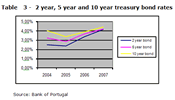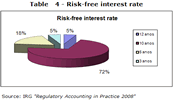The risk-free interest rate reflects the rate of return on risk-free assets. In financial and regulatory practice, treasury bonds are generally considered to a reliable indicator and good parameter for reflecting an absence of risk, as is visible in the Benchmark performed by PwC 1, which recommends the use of this indicator to determine the risk-free interest rate. A similar position is included in the IRG’s PIBs with respect to the risk-free interest rate (PIB 6 2).
In this context, the definition of the methodology for selecting the appropriate treasury bonds, was based on three key aspects: relevant market, maturity and type of data series.
(i) Relevant market: Typically, the domestic market should be chosen as the relevant market. However, in the event that local bonds are not issued on a consistent basis or where they lack liquidity, both PwC and the IRG support the choice of another market.
According to the PwC report, it appears that the preference of regulators 3 is centred on the use of bonds corresponding to the domestic market.
However, given the possibility that the Portuguese market may lack liquidity, the alternative use of assets of a benchmark foreign market is considered for the purposes of calculating the risk-free interest rate. In its report, PwC made a comparison along these lines, using the German bund, the long-term German federal government bond, as a benchmark, concluding that Portuguese bond rates have been more stable 4.
It noted that PTC operates exclusively in Portugal, and that Portuguese bonds therefore provide a better reflection of the specific risk of the country. Meanwhile, according to the issue of treasury bonds (See Table 2) over the last 9 years, it appears that there is a sufficiently liquid market in these bonds (e.g. 10 year treasury bonds) to allow their use as a proxy for the risk-free interest rate.
In this respect, ICP-ANACOM favours the choice of these bonds issued by the Portuguese State, which have been used by the PTC.
(ii) Maturity: Maturity should be assessed according to the returns expected by shareholders, the average period of the depreciation PTC's assets and the regulatory period.
However, taking into account that: (i) longer maturity treasury bonds (15 and 20 years) are not issued annually in a systematic way and have less liquidity (See table 2) and (ii) shorter maturity bonds (2 and 5 years) suffer higher levels of volatility (See table 3) and do not have a timeframe which is in line with the expected investment period, the 10 year treasury bond, already used by the PTC, appears to be the most appropriate for use in the model as a parameter which reflects the return on risk-free assets.
|
EUR millions |
1998 |
1999 |
2000 |
2001 |
2002 |
2003 |
2004 |
2005 |
2006 |
|
Treasury bonds (1) |
8 518 |
9 079 |
7 674 |
8 644 |
12 998 |
7 571 |
6 700 |
16 742 |
13 911 |
|
< 5 years |
287 |
0 |
0 |
0 |
0 |
5 071 |
4 200 |
1 800 |
0 |
|
5 years |
2 861 |
3 537 |
2 527 |
3 386 |
5 817 |
0 |
0 |
3 000 |
3 000 |
|
10 years |
3 015 |
5 000 |
5 147 |
5 258 |
5 036 |
2 500 |
2 500 |
5 856 |
5 800 |
|
15 years |
2 355 |
542 |
0 |
0 |
2 145 |
0 |
0 |
6 086 |
0 |
|
30 years |
0 |
0 |
0 |
0 |
0 |
0 |
0 |
0 |
5 111 |
(1) Nominal bond value according to original maturity. Includes Euro-bonds in 1998
Source: Banco Espírito Santo
Table 3 - 2 year, 5 year and 10 year treasury bond rates
In the study prepared by PwC, preference is also given to the use of 10 year treasury bonds 5.
The IRG 6 also presents a study citing the preference of various regulatory bodies with respect to the maturity of the bonds, noting that the preferred maturity corresponds to 10-year bonds (72%) (See Table 4).
Table 4 - Risk-free interest rate
(iii) Series: One last aspect which should be taken into account is the type of data series which should be used, i.e. whether it should be based on historical observations or on current observations (observations of the day), and also the frequency of observations to be considered (monthly or quarterly).
For regulatory purposes - and bearing in mind that volatility should be minimised and that the rates observed on a particular day may contain distortions, which would be smoothed out in a historical series - the series to be used should be historical, covering a relatively long time period, for which purpose a period of two years is deemed as appropriate. In this regard, PTC has used a series of one year.
As regards the frequency of observation, it is noted that the use of a monthly series has advantages over a quarterly series, allowing: (i) greater detail of the sample compiled, and (ii) reducing errors in the calculation of the series average. In this context, ICP-ANACOM considers that the use of a series based on monthly observations to be appropriate, which has also been used by PTC.
Consequently, the risk-free interest rate should be calculated by using 10 year treasury bonds issued by the Portuguese State. To calculate the rate of cost of capital to apply in the three-year period of 2009-2011, the series used should be that comprising monthly observations, with reference to the last two years, obtaining the value of 4.47% (data from the Bank of Portugal for the period between January 2007 and December 2008).
1 See PwC 2009 Report - pg. 14.
2 The IRG considers that treasury bonds provide a reliable parameter that can be used as a good proxy for the risk-free interest rate. It is likewise stressed that certain criteria must be taken into account, with respect to the maturity, the period of the data series and the market where the company operates.
3 Arcep, Agcom, NPT, CMT, OFCOM and ERSE.
4 The PwC report presents a graphical comparison between the two instruments covering the period between January 2004 and January 2009, noting that while the two instruments remained aligned in the period from January 2006 until July 2007, from July 2007 Portuguese bonds have been more stable.
5 See PwC Report - pg. 20.
6 This study refers to data compiled by the IRG with respect to the CMPC in 26 countries that are part of the IRG and is covered in the report "Regulatory Accounting in Practice 2008".






